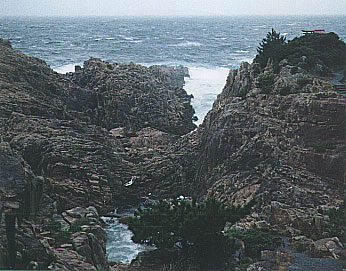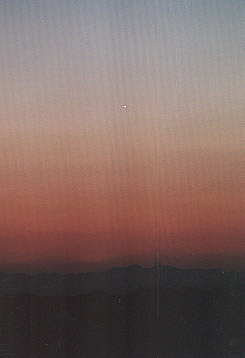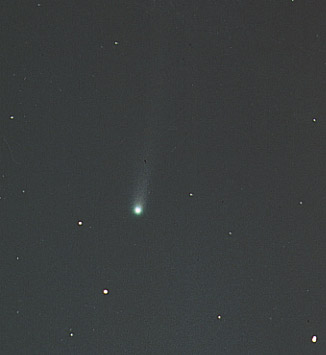
| Return |
| • March 25 We haven't been lucky with weather since my blunder of March 21 while observing C/2002 F1. Even though fine weather was forecast, it would often turn out to be a typical springtime cloudy night or dark clouds would roll in with cold wintry blasts, thus hiding the stars from our view. This has continuously prevented us from observing Comet Utsunomiya. On March 21 I got up at 4 o'clock in the morning. I left home at 7 for Cape Ashizurimisaki, which was a four-hour drive. The purpose of the trip was to see a strange beach there. It was a place called Usubae near Tosashimizu City. This beach was off the beaten track and known only to anglers. Walking through a small torii shinto gateway down to the beach from the western cliff of the Cape, you will find the extraordinary sight of huge rocks and a panorama of the Pacific Ocean right in front of your eyes. Although it was raining, I was awestruck and oblivious to my camera getting wet. I took my Minox camera out of my pocket to capture the scene on film. I thought a small "spy" camera like this would be just right for an inaccessible place known to only few people. It was such a hectic day today that I drove over 400 kilometers. I wanted to go to the observatory at night, but it was cloudy. I am happy as long as I am on the move. |
|

|
|
|
• March 21 • March 15 Mercury, a bright lonely white point of light, caught my eyes in the pink-colored evening sky, while I was waiting for reluctant twilight to progress at the observatory. (See Photograph 1) It appeared as a slightly reddish disk through the 20cm refractor at 40x mounted to the 60cm reflector. At 18:40, as soon as I aimed the 20cm telescope at the comet's predicted position, I glimpsed the comet against the pale background. It was magnitude 4.8 and the coma was a little short of 10' in diameter. It was not bright enough to be visible to the naked-eye. Photograph 2 was taken by the ε210. The blue coma and tail were impressive. |
|
 Photo 1 Mercury in the evening sky  Photo 2 Comet Ikeya-Zhang C/2002 C1 (Trimmed for the center of the photograph) |
|
| • March 4 During the daytime, I went to the observatory with Mr. Keiichiro Okamura, a member of the observatory staff, to do some work. We did some repair work on the pathway from the parking area to the observatory buildings. It was a public viewing day today, but there were no visitors. I stayed on at the observatory to make evening observations. I was anxious about an approaching low air-mass system, as they would affect us half a day earlier than forecast. As expected, clouds gathered in the west soon after the sunset; after only a 30-minute observation of Comet Ikeya-Zhang, Through the 20cm refractor at 60x the coma was 7' in diameter and m1 was 5.0. The tail was faint. I am hopeful that Ikeya-Zhang is identical with the comet of 1661 as some people suggest and that it becomes brighter and larger. However, from the way it looks at the moment, it doesn't seem to be on its way to a naked-eye visibility. In those days following the invention of the telescope, people would only notice comets with a certain size of the coma. If the coma was small, it would be difficult to differentiate from the stars. C/2002 C1 makes me anxious because of its small size. When the arc of the comet's orbit over a period of two months is confirmed and the perturbations by the planets are traced back, we may be able to see some clues to its identity. Three precise positions of the comet are provided in Reports from Geisei Observatory. However, the center of the coma could not be determined precisely resulting in an error margin of ±1". I hope these are useful for your calculations. The deviation from Mr. Sato's latest orbital calculations is about 1". I hope these observations make Comet Ikeya-Zhang 's orbit closer to that of the comet of 1661. Next observation will be made on Friday.. |
Copyright (C) 2002 Tsutomu Seki.